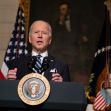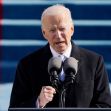It’s not quite the future imagined in The Jetsons, a 1960s cartoon that showed each family with its own flying car and robot maid. But President Biden’s latest Executive Order that paves the way for half of all new vehicles sold in 2030 to be electric ones with zero emissions will put America one step closer to the space-age world presented in amination imagination sixty years ago.
Biden’s executive order has an “ambitious new target” that calls for the advancements in several innovative technologies that will support the electric-vehicle switch over, including electric batteries and plug-in hybrid electric or fuel cell vehicles. In addition, it calls for the creation of the “first-ever” national network of electric vehicle charging stations, a must-have if electric vehicles are to meet the needs of long-distance driving.
In a fact sheet released on August 5, the White House announced that the president’s “Build Back Better” agenda hopes to catapult the U.S. into the global forefront of transportation. Although the country leads the world in developing clean-energy electric vehicles, America’s market share of sales is now only one-third of China’s.
Biden’s plan to develop “the next generation of clean technologies” is clearly motivated by the global climate crisis, emphasized by the Intergovernmental Panel on Climate Change’s (IPCC) report, released by the United Nations (UN) on August 9. The frightening reality described in IPCC says that global warming is close to “spiraling out of control” and warns the world of what Reuters says are “deadly heatwaves, gargantuan hurricanes and other weather extremes that are already happening and) will only become more severe.” Not surprisingly, The UN report said that “Humans are unequivocally to blame.”
Sadly, the President’s futuristic clean energy agenda was not included in the infrastructure bill passed by the Senate on August 10. That doesn’t mean it’s dead; it does mean that proposals to add tax credits and rebates in budget bills for electric vehicle purchasers are hot-button issues that have already divided the Senate into two opposing-party camps.
Unlike many issues, however, the development of clean energy vehicles does not pit corporate America against consumers’ need for affordable cars and good-paying jobs. Representatives of Ford, General Motors, Stellantis (a global carmaker that includes Chrysler), and The United Auto Workers joined Biden at the White House to show their support for his new plan. Ford has already sold almost 800,000 F-series pickups that never have to fill up on gas and boast instant torque. Their trucks can even provide backup power to residences in the event of a blackout, Ford claims.
The President’s Executive Order has other features and a path of its own outside the Senate that he hopes will “save consumers money, cut pollution, boost pubic health, advance environmental justice, and tackle the climate crisis.” For example, the Environmental Protection Agency (EPA) and the Department of Transportation (USDOT) are working to reverse the “harmful rollbacks of near-term fuel efficiency and emission standards” that were abolished by the previous administration.
The two agencies are in the process of making rules they say will “save about 200 billion gallons of gasoline, and reduce around two hundred billion metric tons of carbon pollution.” The Department of Commerce already announced $3 billion in American Rescue Plan funds that will be used to “advance the domestic vehicle industry in communities that have historically been the backbone of the auto industry.”
The new Executive Order follows Biden’s April 22 announcement of a greenhouse gas pollution reduction target that is aimed at creating new “good-paying union jobs and securing U.S. leadership on clean energy technologies.
In addition, Biden’s new plan directs federal agencies to work with the states. For example, the “California Framework Agreement” already involves the state with five automakers: Ford, Honda, Volkswagen, BMW and Volvo in joint efforts to reduce vehicle emissions. It also pledges to involve all stakeholders -- from manufacturers to workers to environmental justice organizations and public health experts, in future decision making.
The White House fact sheet concludes, “Together, today’s announcements would put us on track to reduce greenhouse gas emissions from new passenger vehicle sales by more than 60 percent in 2030 compared to vehicles sold last year, and facilitate achieving the President’s goal of 50-52 percent net economy-wide greenhouse gas emission reductions below 2005 levels in 2030.”






